It is day four of Cinefest, the 17th International Festival of German Film-Heritage. The beautiful Dutch actress Lien Deyers (1910-1965) was discovered by famous director Fritz Lang who gave her a part in his classic Spione/Spies (1928). During eight years, she acted in Germany in 32 late silent and early sound films. After 1935 her star faded rapidly and her life ended in tragedy.

Cover of a special issue of Illustrierter Film-Kurier, 1929, no. 1217, for the late silent German film Ich lebe für dich (Wilhelm Dieterle, 1929), starring William/Wilhelm Dieterle and Lien Deyers, and set in a Swiss tuberculosis sanatorium. For years, the young man Bergson has been awaiting his healing in a sanatorium and has become an embittered man. A new patient, the young, pretty, and lively Nicoline, brings sunshine into his life. Love and hope for bettering arise with him, until Nicoline is declared to be healed again...
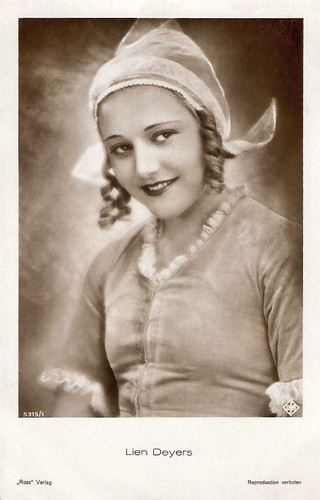
German postcard by Ross Verlag, no. 5315/1, 1930-1931 Photo: Ufa. Collection: Geoffrey Donaldson Institute.
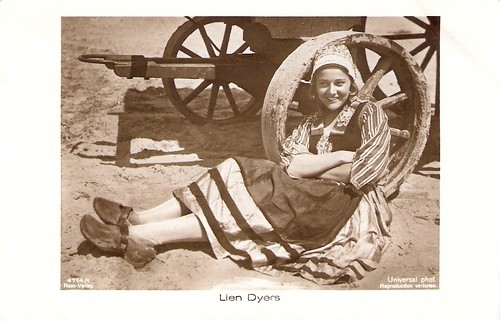
German postcard by Ross Verlag, no. 4714/1, 1929-1930. Photo: Universal.
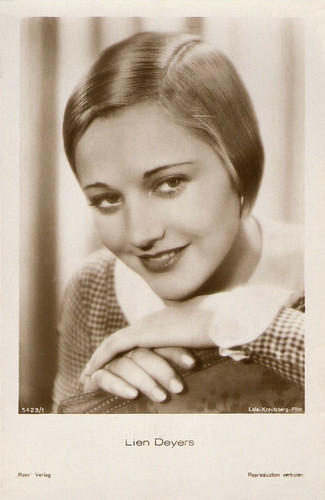
German postcard by Ross Verlag, no. 5423/1, 1930-1931. Photo: Lola-Kreutzberg-Film.
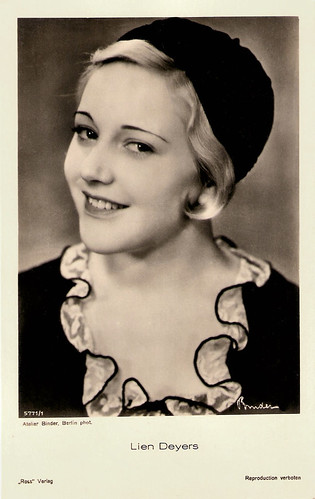
German postcard by Ross Verlag, no. 5771/1, 1930-1931. Photo: Alex Binder.
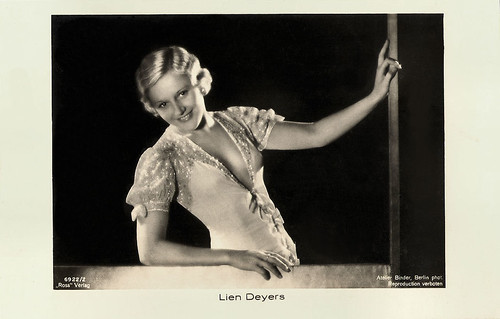
German postcard by Ross-Verlag, no. 6922/2, 1931-1932. Photo: Atelier Binder. Collection: Geoffrey Donaldson Institute.
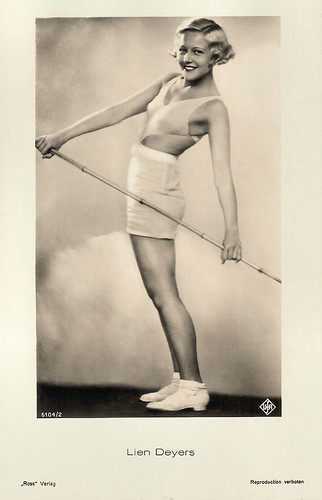
German postcard by Ross Verlag, no. 6104/2, 1931-1932. Photo: Ufa. Collection: Geoffrey Donaldson Institute.
Lien Deyers was born in Amsterdam as Nicolina Spanier. She was the daughter of Nathan Spanier, a piano teacher, and Johanna Liefjes, a seamstress. She had a half-brother, Andries Liefjes. After Spanier’s death, Mrs. Liefjes married the hotel owner Egbert Dijjers and the family moved to The Hague. In 1931 Lien officially changed her name to Dijjers Spanier but would occasionally also use the name Dijjers Liefjes. Several times she stated her year of birth being 1910 or 1911, but some sources mention 1909 as the year of her birth.
She lived her childhood years in Amsterdam and later The Hague until her stepfather, owner of a big hotel in The Hague, married the Austrian actress Lotte Erol. Lien then travelled between The Hague, Vienna (where the family mostly lived), and Lausanne, where she went to a private school and became fluent in French. In August 1926 the Austrian weekly Mein Film staged a competition for new young screen talent and Lien submitted her photograph. Together with twenty other contestants, she was chosen for a screen test by director Hans Otto, which she won.
During an autograph session in the Mein Film offices in 1927, she was introduced to the Austrian director Fritz Lang. Reportedly, the Dutch teenager cheekily asked him: “Herr Lang, don’t you want to discover me?” The endeared director offered the self-assured little blonde girl a plum part in his next project, the thriller Spione/Spies (Fritz Lang, 1928) opposite Rudolf Klein-Rogge and Gerda Maurus. Lang had her travel to Berlin for a screentest and she was indeed given a secondary but racy role in Spione. She was billed as Lien Deyers because Dijjers was frequently misspelt or mispronounced in German-speaking countries.
Lang had her sign a six-year contract and assigned her to the huge Ufa studios in Berlin. The contract soon turned out to be mere slavery, and Deyers sought a court decision to end it. In November 1928 the court ruled in her favour, a verdict welcomed by hundreds of Berlin-based actors with similar contracts. In turn, Lang appealed and was granted a 10,000 Reichs-mark pay-off, to be fulfilled in monthly payments. Deyers and Lang had already grown to dislike each other during the shooting of Spione.
Her role as an alluring and seductive spy in Spione meant the start of a prolific film career in the German cinema for Lien. In the next two years, she starred in films like Haus Nummer 17/Number 17 (Géza von Bolváry, 1928), Die Heilige und ihr Narr/The Saint and Her Fool (Wilhelm Dieterle, 1928), and the French adventure Le Capitaine Fracasse/Captain Fracasse (Alberto Cavalcanti, Henry Wulschleger, 1929) starring Pierre Blanchar.
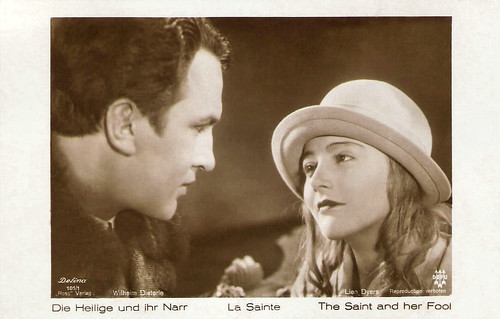
German postcard by Ross Verlag, no. 101/1, 1927-1928. Photo: Defina / DEFU. Publicity still for Die Heilige und ihr Narr/The Saint and her Fool (Wilhelm Dieterle, 1928) with Wilhelm Dieterle.

German postcard by Ross Verlag, no. 3525/1, 1928-1929. Photo: Atelier Schrecker, Berlin.
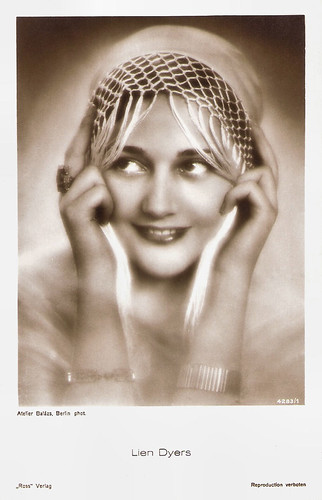
German postcard by Ross Verlag, no. 4283/1, 1929-1930. Photo: Atelier Balázs, Berlin. Collection: Geoffrey Donaldson Institute.

German postcard by Ross Verlag, no. 4283/2, 1929-1930. Photo: Atelier Balázs, Berlin.
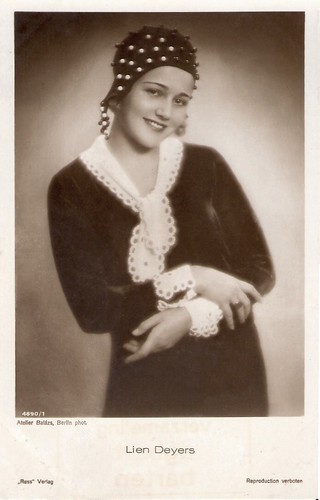

German postcards by Ross Verlag, no. 4890/1 and 4890/2, 1929-1930. Photo: Atelier Balázs, Berlin. Collection: Geoffrey Donaldson Institute.

Austrian postcard by Iris Verlag, no. 5693. Photo: Manassé, Wien. Collection: Geoffrey Donaldson Institute.

Austrian postcard by Iris-Verlag, no. 5694. Photo: Manassé.
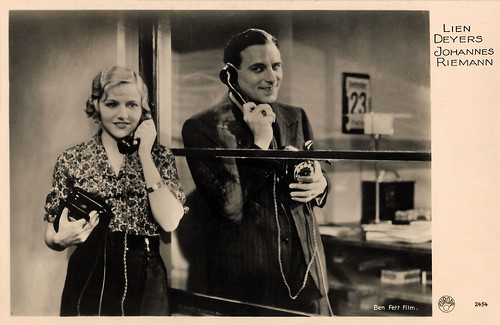
French postcard by Europe, no. 2454. Photo: Ben Fett Film. Lien Deyers and Johannes Riemann in Sein Scheidungsgrund/His Grounds for Divorce (Alfred Zeisler, 1931).
After eight silent films, Lien Deyers had also success with her early sound films.
She enchanted the public with her appearances in films like Rosenmontag/Rose Monday (Hans Steinhoff, 1930), Die Männer um Lucie/The Men Around Lucie (Alexander Korda, 1931) starring Liane Haid, and the operetta Die Verliebte Firma/The Company's in Love (Max Ophüls, 1932) with Gustav Fröhlich.
She starred opposite Heinz Rühmann in the comedy hits Der Mann, der seinen Mörder sucht/Looking for His Murderer (Robert Siodmak, 1931) and Lachende Erben/Laughing Heirs (Max Ophüls, 1933).
Opposite the popular singer Richard Tauber, she appeared in Melodie der Liebe/Right to Happiness (Georg Jacoby, 1932), and opposite another singing star, Jan Kiepura in Ich liebe alle Frauen/I Love All Women (Carl Lamac, 1935).
In the interesting Sci-Fi film Gold (Karl Hartl, 1934) she played opposite Hans Albers and Brigitte Helm.

German postcard by Ross Verlag, no. 4770/1, 1929-1930. Photo: Atelier Schrecker, Berlin. Collection: Geoffrey Donaldson Institute.

German postcard by Ross Verlag, no. 5192/1, 1930-1931. Photo: Atelier Gerstenberg, Berlin. Collection: Geoffrey Donaldson Institute.
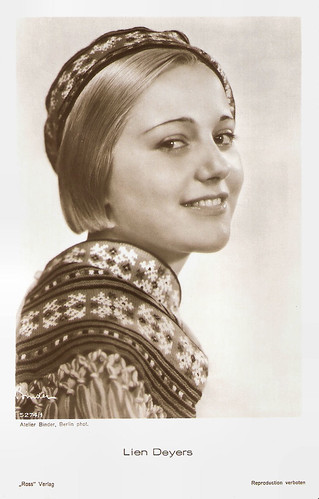
German postcard by Ross Verlag, no. 5274/1, 1930-1931. Photo: Atelier Binder. Collection: Geoffrey Donaldson Institute.>
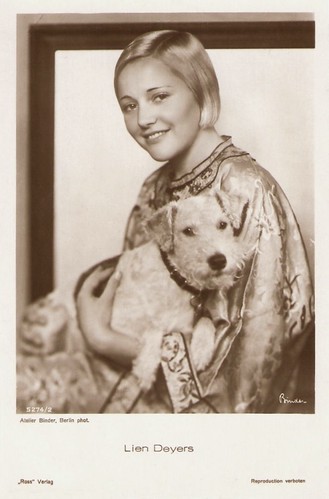
German postcard by Ross Verlag, no. 5274/2, 1930-1931. Photo: Atelier Binder, Berlin.
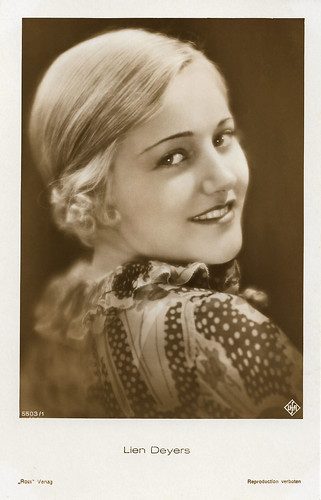
German postcard by Ross Verlag, no. 5503/1, 1930-1931. Photo: Ufa.
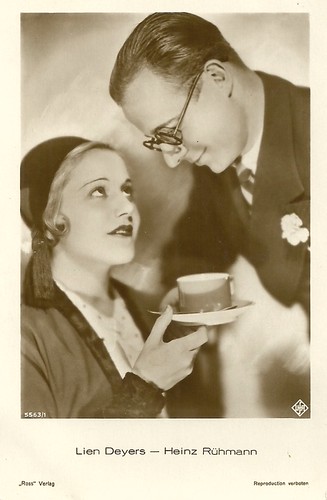
German postcard by Ross Verlag, no. 5563/1, 1930-1931. Photo: Ufa. Publicity still for Der Mann, der seinen Mörder sucht/Looking for His Murderer (Robert Siodmak, 1931) with Heinz Rühmann.
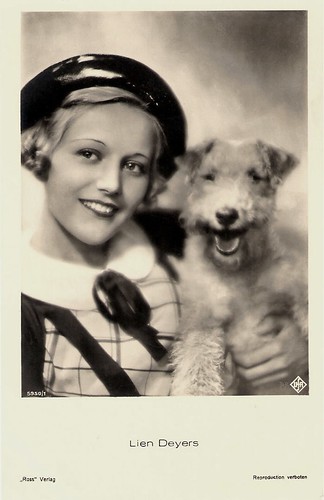
German postcard by Ross Verlag, no. 5950/1, 1930-1931. Photo: Ufa.

Dutch postcard for De sensatie der toekomst (Dimitri Buchowetzki, Jack Salvatori, 1931) with Roland Varnoand Dolly Bouwmeester. Lien Deyers was not in the film, but visited the Paramount studios during the shooting.
Lien Deyers never appeared in a Dutch film. She can be seen on publicity photos for De sensatie der toekomst/Television (Dimitri Buchowetzki, Jack Salvatori, 1931) starring Dolly Bouwmeester and Roland Varno. This early and little-known Dutch sound film was shot at the Paramount Studios in Joinville in France. The subject was the new phenomenon of television, 'the sensation of the future.
De sensatie der toekomst/Television was the Dutch version of the French film Magie moderne/Modern Magic (Dimitri Buchowetzki, 1931). With different casts, there were also an Italian, a Czech, a Polish, a Romanian, and a Swedish version produced in the same studio. However, Lien Deyers was not in the film but only visited the Paramount studios during the shooting.
Deyers had given up her Dutch nationality when she married American-born German producer and director Alfred Zeisler. Zeisler had directed her in Sein Scheidungsgrund/His Grounds for Divorce (1931) and had produced Gold. Therefore Lien wasn't subject to the foreign-worker quota restrictions of the National Socialists.
Lien was terrified that her family tree would be investigated by the Nazis: her father, a hotel owner in the Hague, was half-Jewish. Her husband was also Jewish. The couple decided to leave Germany.
Among Lien Deyer's last films were Ein ganzer Kerl/A Regular Fellow (Carl Boese, 1935) and Die Selige Exzellenz/The Blessed Excellency (Hans H. Zerlett, 1935). The pair left for England first.
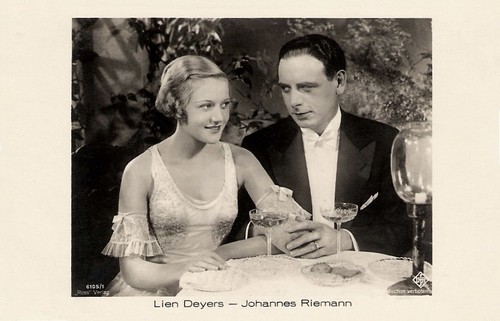
German postcard by Ross Verlag, no. 6105/1, 1931-1932. Photo: Ufa. Collection: Geoffrey Donaldson Institute. Publicity still for Sein Scheidungsgrund/His Grounds for Divorce (Alfred Zeisler, 1931) with Johannes Riemann.
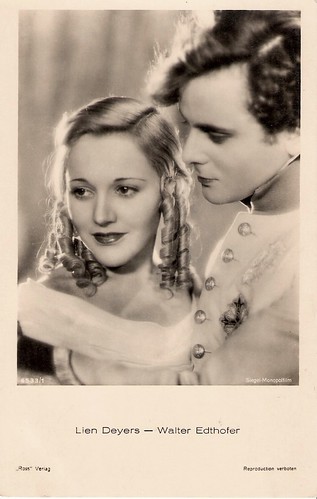
German postcard by Ross Verlag, no. 6533/1, 1931-1932. Photo: Siegel-Monopolfilm. Still from Der Herzog von Reichstadt/The Duke of Reichstadt (Victor Tourjansky, 1931) with Walter Edthofer. Collection: Geoffrey Donaldson Institute.
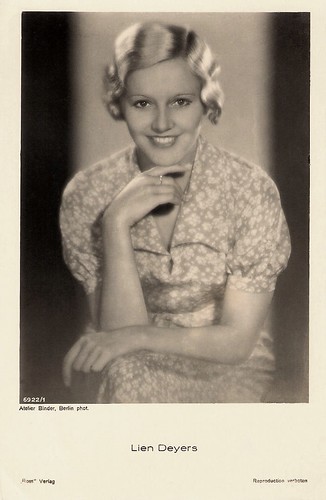
German postcard by Ross Verlag, no. 6922/1, 1931-1932. Photo: Atelier Binder, Berlin.
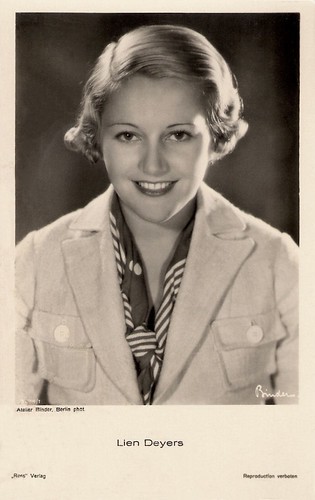
German postcard by Ross Verlag. Photo: Atelier Binder, Berlin.
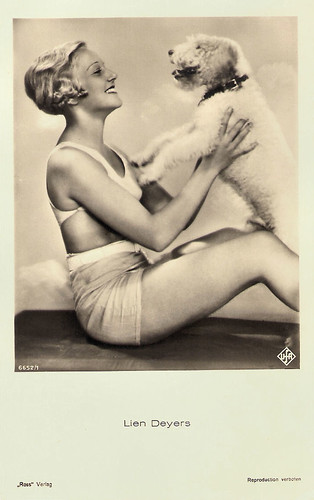
German postcard by Ross Verlag, no. 6552/1, 1931-1932. Photo: Ufa. Collection: Geoffrey Donaldson Institute.

German postcard by Ross Verlag, no. 608 (Luxus series). Photo: Atelier Binder. Collection: Geoffrey Donaldson Institute.
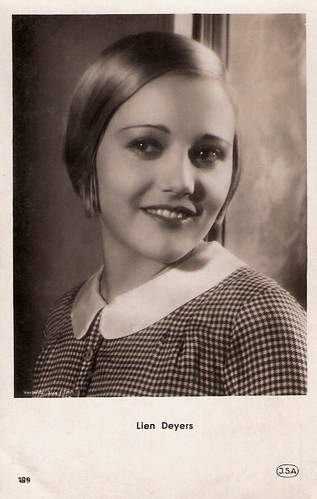
Dutch postcard by J.S.A., no. 189. Photo: Lux Film.
Lien Deyers travelled between London and The Hague while her man worked in England. In 1937 she signed for a major role in the Dutch-Italian film De Drie Wensen/I Tre Desideri/Three Wishes. For unknown reasons, she did not play the part and finally joined her husband in London in 1938. There was no need for her acting skills there.
By that time her marriage with Alfred Zeissler was faltering and divorce was inevitable. In 1939 the couple moved to California where they soon went their different ways. Lien Deyers couldn't find work in the film business in Hollywood and conducted a business for novelties. According to Wikipedia, she had a reputation now of being 'mentally extremely unstable'.
She developed an alcohol addiction and relied financially on old contacts like the German actor and director William Dieterle and in particular the Austrian-American film producer Paul Kohner and his European Film Fund that he had founded to aid down-on-their-luck German actors in exile.
Over a brief period, she married three more times: with kingpin actors' agent Frank Orsatti, one of the Orsatti Brothers (who evidently couldn't get her involved in films either), from 1940 until 1942, with furrier Victor Rubin (from 1944 until 1948) and with Lawrence Adlon, grandson of the Berlin hotel-magnate, in January 1951.
In the following decades, her private life was marked with some setbacks. Lien became an alcoholic. The Dutch actor/comedian Wim Sonneveld met with her in 1957 during the shooting of Silk Stockings with Fred Astaire and Cyd Charisse, in which he played a supporting role. He was reportedly shocked by her faded beauty.
Then, Lien Deyers completely vanished from the public view. The last time she was heard from, was in September 1964, when she was in the Clark County Jail in Las Vegas because of loitering and disorderly conduct.
Thomas Staedeli at Cyranos: "The time of her death is not ascertainable, (...) but it seems that she died in 1965". Wikipedia mentions a greeting card congratulating German actor and former co-star Heinz Rühmann on his eightieth birthday in 1982. The postcard was signed L. Dyers-Wallburg, suggesting she had gotten married for the fifth time. IMDb has 1982 as the year of her death.

German postcard by Ross Verlag, no. 5771/1, 1930-1931. Photo: Alex Binder.

German postcard by Ross Verlag, no. 6536/1, 1931-1932. Photo: Atelier Binder. Collection: Geoffrey Donaldson Instituut.
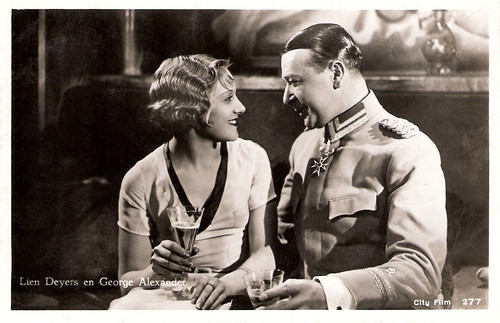
Dutch postcard by City Film, no. 277. Collection: Geoffrey Donaldson Institute. Publicity still for Ist mein Mann nicht fabelhaft?/Isn't My Husband Wonderful? (Georg Jacoby, 1933) with Georg Alexander

German postcard by Ross Verlag, no. 7194/1, 1932-1933. Photo: Atelier Binder, Berlin.

German postcard by Ross Verlag, no. 7749/1, 1932-1933. Photo: Atelier Binder, Berlin.
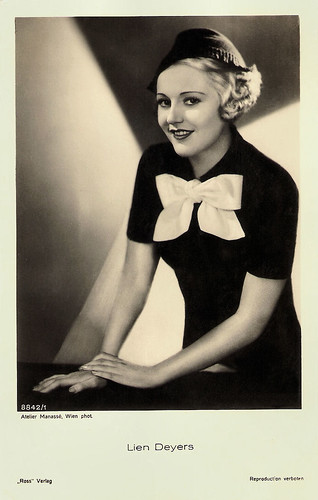
German postcard by Ross Verlag, no. 8842/1, 1933-1934. Photo: Atelier Manassé, Wien. Collection: Geoffrey Donaldson Institute.
Sources: Adrian Stahlecker (Nederlandse acteurs in de Weimarrepubliek en Nazi-Duitsland - Dutch), Thomas Staedeli (Cyranos), Filmportal.de, Wikipedia (English and Dutch) and IMDb.
This post was last updated on 4 January 2024.

Cover of a special issue of Illustrierter Film-Kurier, 1929, no. 1217, for the late silent German film Ich lebe für dich (Wilhelm Dieterle, 1929), starring William/Wilhelm Dieterle and Lien Deyers, and set in a Swiss tuberculosis sanatorium. For years, the young man Bergson has been awaiting his healing in a sanatorium and has become an embittered man. A new patient, the young, pretty, and lively Nicoline, brings sunshine into his life. Love and hope for bettering arise with him, until Nicoline is declared to be healed again...

German postcard by Ross Verlag, no. 5315/1, 1930-1931 Photo: Ufa. Collection: Geoffrey Donaldson Institute.

German postcard by Ross Verlag, no. 4714/1, 1929-1930. Photo: Universal.

German postcard by Ross Verlag, no. 5423/1, 1930-1931. Photo: Lola-Kreutzberg-Film.

German postcard by Ross Verlag, no. 5771/1, 1930-1931. Photo: Alex Binder.

German postcard by Ross-Verlag, no. 6922/2, 1931-1932. Photo: Atelier Binder. Collection: Geoffrey Donaldson Institute.

German postcard by Ross Verlag, no. 6104/2, 1931-1932. Photo: Ufa. Collection: Geoffrey Donaldson Institute.
Fritz Lang
Lien Deyers was born in Amsterdam as Nicolina Spanier. She was the daughter of Nathan Spanier, a piano teacher, and Johanna Liefjes, a seamstress. She had a half-brother, Andries Liefjes. After Spanier’s death, Mrs. Liefjes married the hotel owner Egbert Dijjers and the family moved to The Hague. In 1931 Lien officially changed her name to Dijjers Spanier but would occasionally also use the name Dijjers Liefjes. Several times she stated her year of birth being 1910 or 1911, but some sources mention 1909 as the year of her birth.
She lived her childhood years in Amsterdam and later The Hague until her stepfather, owner of a big hotel in The Hague, married the Austrian actress Lotte Erol. Lien then travelled between The Hague, Vienna (where the family mostly lived), and Lausanne, where she went to a private school and became fluent in French. In August 1926 the Austrian weekly Mein Film staged a competition for new young screen talent and Lien submitted her photograph. Together with twenty other contestants, she was chosen for a screen test by director Hans Otto, which she won.
During an autograph session in the Mein Film offices in 1927, she was introduced to the Austrian director Fritz Lang. Reportedly, the Dutch teenager cheekily asked him: “Herr Lang, don’t you want to discover me?” The endeared director offered the self-assured little blonde girl a plum part in his next project, the thriller Spione/Spies (Fritz Lang, 1928) opposite Rudolf Klein-Rogge and Gerda Maurus. Lang had her travel to Berlin for a screentest and she was indeed given a secondary but racy role in Spione. She was billed as Lien Deyers because Dijjers was frequently misspelt or mispronounced in German-speaking countries.
Lang had her sign a six-year contract and assigned her to the huge Ufa studios in Berlin. The contract soon turned out to be mere slavery, and Deyers sought a court decision to end it. In November 1928 the court ruled in her favour, a verdict welcomed by hundreds of Berlin-based actors with similar contracts. In turn, Lang appealed and was granted a 10,000 Reichs-mark pay-off, to be fulfilled in monthly payments. Deyers and Lang had already grown to dislike each other during the shooting of Spione.
Her role as an alluring and seductive spy in Spione meant the start of a prolific film career in the German cinema for Lien. In the next two years, she starred in films like Haus Nummer 17/Number 17 (Géza von Bolváry, 1928), Die Heilige und ihr Narr/The Saint and Her Fool (Wilhelm Dieterle, 1928), and the French adventure Le Capitaine Fracasse/Captain Fracasse (Alberto Cavalcanti, Henry Wulschleger, 1929) starring Pierre Blanchar.

German postcard by Ross Verlag, no. 101/1, 1927-1928. Photo: Defina / DEFU. Publicity still for Die Heilige und ihr Narr/The Saint and her Fool (Wilhelm Dieterle, 1928) with Wilhelm Dieterle.

German postcard by Ross Verlag, no. 3525/1, 1928-1929. Photo: Atelier Schrecker, Berlin.

German postcard by Ross Verlag, no. 4283/1, 1929-1930. Photo: Atelier Balázs, Berlin. Collection: Geoffrey Donaldson Institute.

German postcard by Ross Verlag, no. 4283/2, 1929-1930. Photo: Atelier Balázs, Berlin.


German postcards by Ross Verlag, no. 4890/1 and 4890/2, 1929-1930. Photo: Atelier Balázs, Berlin. Collection: Geoffrey Donaldson Institute.

Austrian postcard by Iris Verlag, no. 5693. Photo: Manassé, Wien. Collection: Geoffrey Donaldson Institute.

Austrian postcard by Iris-Verlag, no. 5694. Photo: Manassé.

French postcard by Europe, no. 2454. Photo: Ben Fett Film. Lien Deyers and Johannes Riemann in Sein Scheidungsgrund/His Grounds for Divorce (Alfred Zeisler, 1931).
Starring parts
After eight silent films, Lien Deyers had also success with her early sound films.
She enchanted the public with her appearances in films like Rosenmontag/Rose Monday (Hans Steinhoff, 1930), Die Männer um Lucie/The Men Around Lucie (Alexander Korda, 1931) starring Liane Haid, and the operetta Die Verliebte Firma/The Company's in Love (Max Ophüls, 1932) with Gustav Fröhlich.
She starred opposite Heinz Rühmann in the comedy hits Der Mann, der seinen Mörder sucht/Looking for His Murderer (Robert Siodmak, 1931) and Lachende Erben/Laughing Heirs (Max Ophüls, 1933).
Opposite the popular singer Richard Tauber, she appeared in Melodie der Liebe/Right to Happiness (Georg Jacoby, 1932), and opposite another singing star, Jan Kiepura in Ich liebe alle Frauen/I Love All Women (Carl Lamac, 1935).
In the interesting Sci-Fi film Gold (Karl Hartl, 1934) she played opposite Hans Albers and Brigitte Helm.

German postcard by Ross Verlag, no. 4770/1, 1929-1930. Photo: Atelier Schrecker, Berlin. Collection: Geoffrey Donaldson Institute.

German postcard by Ross Verlag, no. 5192/1, 1930-1931. Photo: Atelier Gerstenberg, Berlin. Collection: Geoffrey Donaldson Institute.

German postcard by Ross Verlag, no. 5274/1, 1930-1931. Photo: Atelier Binder. Collection: Geoffrey Donaldson Institute.>

German postcard by Ross Verlag, no. 5274/2, 1930-1931. Photo: Atelier Binder, Berlin.

German postcard by Ross Verlag, no. 5503/1, 1930-1931. Photo: Ufa.

German postcard by Ross Verlag, no. 5563/1, 1930-1931. Photo: Ufa. Publicity still for Der Mann, der seinen Mörder sucht/Looking for His Murderer (Robert Siodmak, 1931) with Heinz Rühmann.

German postcard by Ross Verlag, no. 5950/1, 1930-1931. Photo: Ufa.

Dutch postcard for De sensatie der toekomst (Dimitri Buchowetzki, Jack Salvatori, 1931) with Roland Varnoand Dolly Bouwmeester. Lien Deyers was not in the film, but visited the Paramount studios during the shooting.
The Sensation of the Future
Lien Deyers never appeared in a Dutch film. She can be seen on publicity photos for De sensatie der toekomst/Television (Dimitri Buchowetzki, Jack Salvatori, 1931) starring Dolly Bouwmeester and Roland Varno. This early and little-known Dutch sound film was shot at the Paramount Studios in Joinville in France. The subject was the new phenomenon of television, 'the sensation of the future.
De sensatie der toekomst/Television was the Dutch version of the French film Magie moderne/Modern Magic (Dimitri Buchowetzki, 1931). With different casts, there were also an Italian, a Czech, a Polish, a Romanian, and a Swedish version produced in the same studio. However, Lien Deyers was not in the film but only visited the Paramount studios during the shooting.
Deyers had given up her Dutch nationality when she married American-born German producer and director Alfred Zeisler. Zeisler had directed her in Sein Scheidungsgrund/His Grounds for Divorce (1931) and had produced Gold. Therefore Lien wasn't subject to the foreign-worker quota restrictions of the National Socialists.
Lien was terrified that her family tree would be investigated by the Nazis: her father, a hotel owner in the Hague, was half-Jewish. Her husband was also Jewish. The couple decided to leave Germany.
Among Lien Deyer's last films were Ein ganzer Kerl/A Regular Fellow (Carl Boese, 1935) and Die Selige Exzellenz/The Blessed Excellency (Hans H. Zerlett, 1935). The pair left for England first.

German postcard by Ross Verlag, no. 6105/1, 1931-1932. Photo: Ufa. Collection: Geoffrey Donaldson Institute. Publicity still for Sein Scheidungsgrund/His Grounds for Divorce (Alfred Zeisler, 1931) with Johannes Riemann.

German postcard by Ross Verlag, no. 6533/1, 1931-1932. Photo: Siegel-Monopolfilm. Still from Der Herzog von Reichstadt/The Duke of Reichstadt (Victor Tourjansky, 1931) with Walter Edthofer. Collection: Geoffrey Donaldson Institute.

German postcard by Ross Verlag, no. 6922/1, 1931-1932. Photo: Atelier Binder, Berlin.

German postcard by Ross Verlag. Photo: Atelier Binder, Berlin.

German postcard by Ross Verlag, no. 6552/1, 1931-1932. Photo: Ufa. Collection: Geoffrey Donaldson Institute.

German postcard by Ross Verlag, no. 608 (Luxus series). Photo: Atelier Binder. Collection: Geoffrey Donaldson Institute.

Dutch postcard by J.S.A., no. 189. Photo: Lux Film.
Setback
Lien Deyers travelled between London and The Hague while her man worked in England. In 1937 she signed for a major role in the Dutch-Italian film De Drie Wensen/I Tre Desideri/Three Wishes. For unknown reasons, she did not play the part and finally joined her husband in London in 1938. There was no need for her acting skills there.
By that time her marriage with Alfred Zeissler was faltering and divorce was inevitable. In 1939 the couple moved to California where they soon went their different ways. Lien Deyers couldn't find work in the film business in Hollywood and conducted a business for novelties. According to Wikipedia, she had a reputation now of being 'mentally extremely unstable'.
She developed an alcohol addiction and relied financially on old contacts like the German actor and director William Dieterle and in particular the Austrian-American film producer Paul Kohner and his European Film Fund that he had founded to aid down-on-their-luck German actors in exile.
Over a brief period, she married three more times: with kingpin actors' agent Frank Orsatti, one of the Orsatti Brothers (who evidently couldn't get her involved in films either), from 1940 until 1942, with furrier Victor Rubin (from 1944 until 1948) and with Lawrence Adlon, grandson of the Berlin hotel-magnate, in January 1951.
In the following decades, her private life was marked with some setbacks. Lien became an alcoholic. The Dutch actor/comedian Wim Sonneveld met with her in 1957 during the shooting of Silk Stockings with Fred Astaire and Cyd Charisse, in which he played a supporting role. He was reportedly shocked by her faded beauty.
Then, Lien Deyers completely vanished from the public view. The last time she was heard from, was in September 1964, when she was in the Clark County Jail in Las Vegas because of loitering and disorderly conduct.
Thomas Staedeli at Cyranos: "The time of her death is not ascertainable, (...) but it seems that she died in 1965". Wikipedia mentions a greeting card congratulating German actor and former co-star Heinz Rühmann on his eightieth birthday in 1982. The postcard was signed L. Dyers-Wallburg, suggesting she had gotten married for the fifth time. IMDb has 1982 as the year of her death.

German postcard by Ross Verlag, no. 5771/1, 1930-1931. Photo: Alex Binder.

German postcard by Ross Verlag, no. 6536/1, 1931-1932. Photo: Atelier Binder. Collection: Geoffrey Donaldson Instituut.

Dutch postcard by City Film, no. 277. Collection: Geoffrey Donaldson Institute. Publicity still for Ist mein Mann nicht fabelhaft?/Isn't My Husband Wonderful? (Georg Jacoby, 1933) with Georg Alexander

German postcard by Ross Verlag, no. 7194/1, 1932-1933. Photo: Atelier Binder, Berlin.

German postcard by Ross Verlag, no. 7749/1, 1932-1933. Photo: Atelier Binder, Berlin.

German postcard by Ross Verlag, no. 8842/1, 1933-1934. Photo: Atelier Manassé, Wien. Collection: Geoffrey Donaldson Institute.
Sources: Adrian Stahlecker (Nederlandse acteurs in de Weimarrepubliek en Nazi-Duitsland - Dutch), Thomas Staedeli (Cyranos), Filmportal.de, Wikipedia (English and Dutch) and IMDb.
This post was last updated on 4 January 2024.
No comments:
Post a Comment